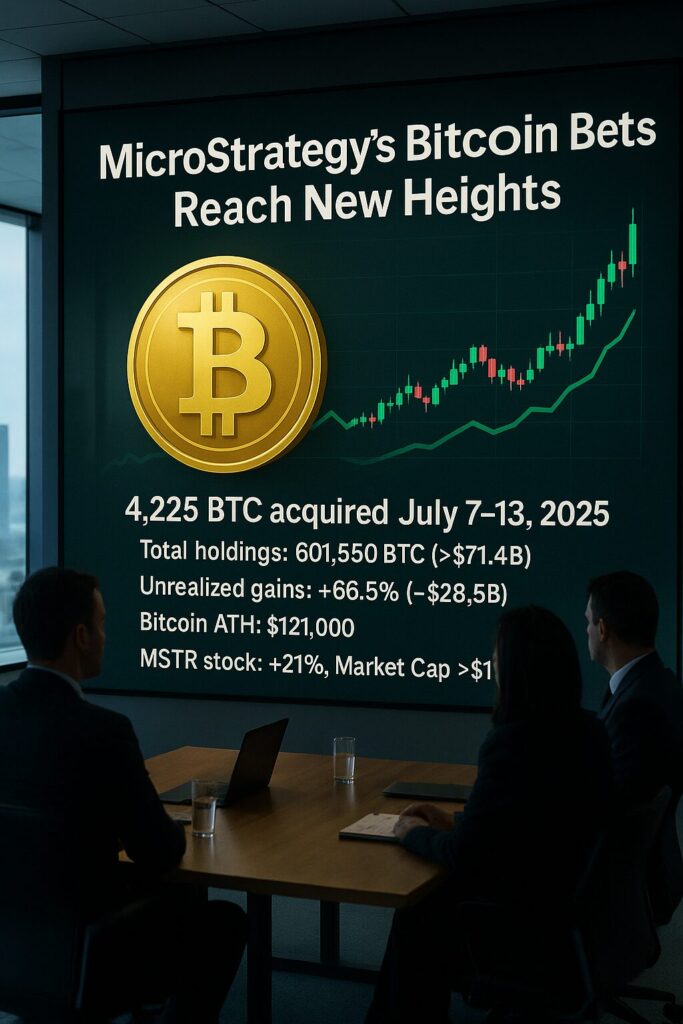
Main Points:
- MicroStrategy acquired 4,225 BTC for $472.5 million between July 7–13, 2025, bringing its total to 601,550 BTC (valued at over $71.4 billion).
- The company’s Bitcoin holdings are up ~66.5 %, generating more than $28.5 billion of unrealized gains.
- Bitcoin reached fresh all-time highs above $121,000 amid “Crypto Week” in Washington, D.C., fueling demand for crypto-linked equities.
- MicroStrategy’s stock (MSTR) surged over 21 % in the past month, pushing its market cap past $118 billion.
- Institutional investors—especially those barred from direct BTC ownership—are increasing exposure via MicroStrategy shares and convertible bonds.
1. Recent Purchase Details
Between July 7 and July 13, 2025, MicroStrategy (ticker: MSTR) resumed its Bitcoin accumulation, purchasing 4,225 BTC at an average price of $111,827 per coin, for a total outlay of $472.5 million. This latest acquisition elevated the company’s Bitcoin treasury to 601,550 BTC, valued on July 14 at $71.4 billion based on spot prices above $118,000.
2. Portfolio Performance and Unrealized Gains
MicroStrategy’s Bitcoin stash has delivered remarkable returns. According to SaylorTracker, the company’s BTC holdings are up approximately 66.5 %, translating into over $28.5 billion in unrealized profits on a cost basis of roughly $42.9 billion. This performance underscores MicroStrategy’s strategy of deploying capital into a long-term digital asset with asymmetric upside.
3. Market Context: Bitcoin Rally and “Crypto Week”
Bitcoin itself has been on a tear, breaking above $121,000 on July 14, 2025, and briefly trading near $123,000 amid optimism over potential Federal Reserve rate cuts and three major crypto regulatory bills in Congress—the CLARITY Act, the GENIUS Act, and the Anti‑CBDC Surveillance State Act—during what the White House dubbed “Crypto Week”.
The rally in Bitcoin’s price has been a key driver of demand not only for the cryptocurrency itself but also for associated equities and ETFs.
4. Impact on MicroStrategy’s Stock
MicroStrategy’s stock price has mirrored its cryptocurrency holdings’ appreciation. Over the past month, MSTR shares climbed 21.52 %, peaking at $451.02 on July 14—an eight‑month high and a 3.8 % gain on the day of the latest purchase announcement. The broader Nasdaq‑100 inclusion, effective December 2024, has also heightened institutional interest in the company’s stock as a proxy for Bitcoin exposure.
5. Institutional Adoption and Indirect Exposure
A growing number of funds face internal mandates that prohibit direct Bitcoin ownership. Consequently, institutional investors have turned to MicroStrategy shares and convertible debt to gain indirect BTC exposure. Vanguard, historically skeptical of cryptocurrencies, now holds 20 million MSTR shares, representing approximately 8 % of the company’s outstanding equity. Other corporate treasury plays, such as GameStop and Genius Group, have likewise added Bitcoin to their reserves to meet investor demand.
6. Strategic Implications for Investors
- Proxy Play: Investors wary of custodial or regulatory complexities can leverage MicroStrategy for pure‑play Bitcoin exposure within a regulated equity framework.
- Liquidity Considerations: MSTR’s free float and daily trading volumes provide ample liquidity compared to spot markets for large trades.
- Counterparty Risk: While equities carry conventional market risks (e.g., dilution, corporate governance), they bypass on‑chain custody challenges inherent in direct holdings.
- Regulatory Landscape: Congressional deliberations during “Crypto Week” signal a maturing regulatory environment that may bolster institutional confidence.
7. Broader Crypto Ecosystem Drivers
Besides treasury companies, three pillars support current Bitcoin demand:
- Spot ETFs: Latest filings have seen record inflows into U.S. and overseas Bitcoin ETFs.
- Institutional Investors: Pension funds, endowments, and family offices increasingly allocate small percentages of AUM to digital assets.
- Centralized Exchanges: Platforms like Binance and Coinbase continue to onboard corporate clients and offer enhanced custodial services.
As these channels expand, they create a feedback loop—higher spot prices drive more buying, which in turn reaffirms the narrative of Bitcoin as an institutional-grade asset.
8. Conclusion
MicroStrategy’s unwavering accumulation of Bitcoin, now over $71 billion worth of BTC, exemplifies a bold corporate treasury strategy anchored in long-term digital-asset conviction. Under Michael Saylor’s leadership, the company has effectively positioned itself as one of the world’s largest unofficial Bitcoin ETFs, attracting institutional capital that faces barriers to direct crypto ownership. With Bitcoin hitting new all-time highs above $121,000 and global regulatory frameworks evolving favorably, MicroStrategy’s model may serve as a blueprint for other corporations seeking diversified treasury and asset-defense strategies. Investors should weigh the benefits of proxy exposure against the inherent equity risks, but the case for MicroStrategy as a strategic Bitcoin proxy remains compelling.

